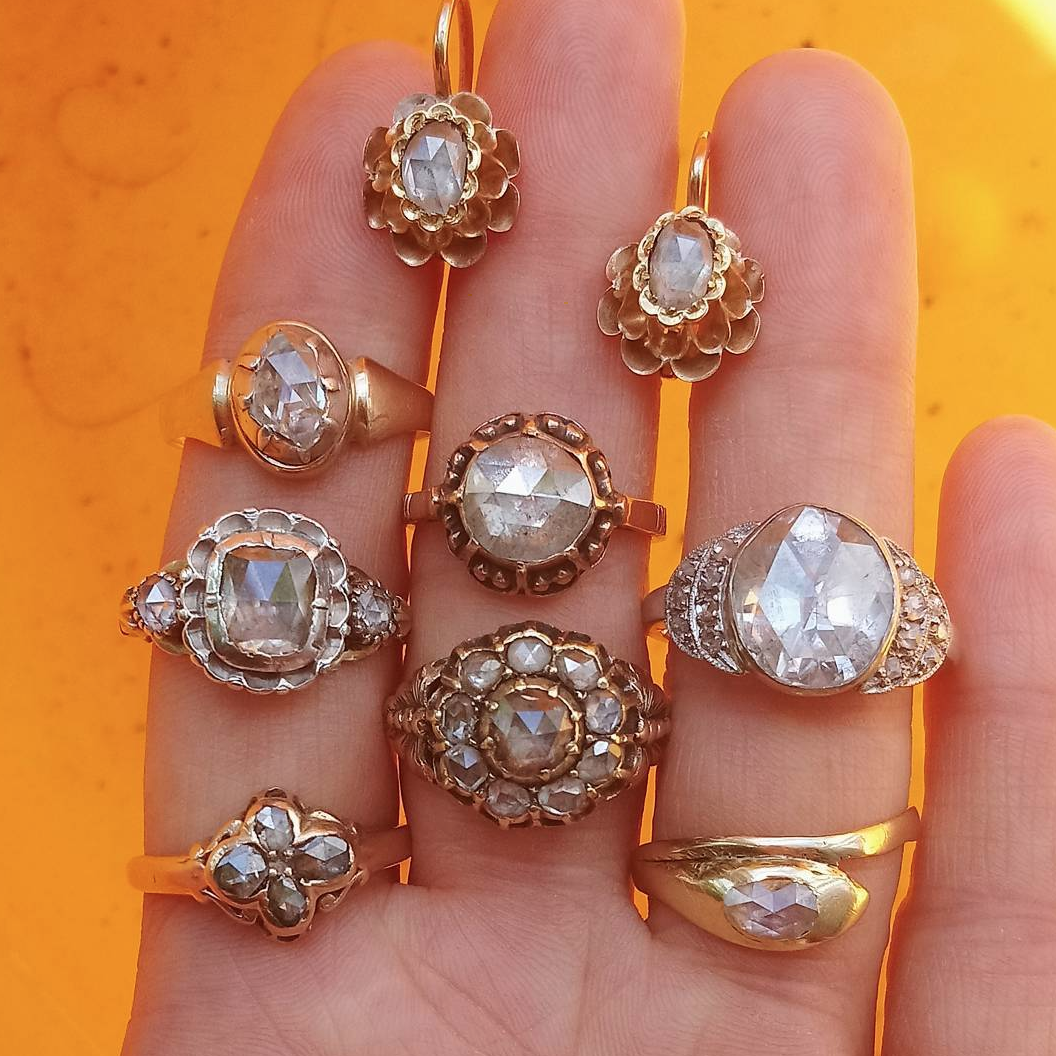The History Of The First Diamond Cuts
The way diamonds have been cut has undergone significant evolution over time, transitioning from the simple point cuts of the Renaissance to the intricate modern brilliant cuts. In this post, I will explore the early diamond cuts from the 14th to the 16th century.
1300s - The point cut
I've always had a magnetic attraction to Renaissance jewelry. It was during this period that diamonds became the talk of the town in Europe, adorning exquisite pieces of jewelry. The initial cuts given to these precious gems were both simple and mind-blowingly beautiful.
You see, diamonds in their natural state possess an octahedral shape. So, in the mid-1300s, the first diamond cutters worked their magic by taking this shape and transforming it into something even more captivating. They polished the octahedral crystal faces, creating smooth and flawless facets. And voila! The point cut was born, showcasing the diamond's brilliance like never before!
Take a look at this remarkable ring from Denmark. It proudly displays stunning point and table cut diamonds. Rumor has it that this ring once graced the finger of Ellen Marsvin (1572-1649), a noblewoman and the mother-in-law of the Danish King Christian IV. Just imagine, it was unearthed from the depths of the soil near one of Ellen's estates in 2014 and has been on display at the Nationalmuseet since 2016. It's a true treasure steeped in history!
1400s - The table cut, old single cut and step cut
During the 1400s, a captivating era of diamond cutting unfolded, witnessing remarkable advancements in techniques. Initially, the point cut reigned supreme for a century, capturing the hearts of jewelry enthusiasts. However, the mid-1400s brought forth a groundbreaking transformation—the birth of the table cut. In this revolutionary cut, a little less than half of the octahedron was artfully removed, giving rise to a symmetrical and alluring diamond shape. The insightful diamond cutters also recognized the significance of a culet, which prompted the inclusion of this facet in some table-cut stones. As if that weren't enough, the introduction of four corner facets ushered in the era of the old single cut, amplifying the diamond's brilliance.
But the 1400s had more in store for us! It was during this period that the step cut made its dazzling entrance, serving as a precursor to the coveted emerald cut diamond. Step cuts boasted horizontally built main facets, creating a mesmerizing stair-like arrangement that extended from the crown to the pavilion. The result? A captivating display of geometric elegance!
Now, brace yourself for a true diamond-cutting revelation. In 1458, a visionary Belgian diamond cutter unearthed a remarkable secret—diamonds could be cut and polished using their own dust! This ingenious innovator not only crafted a diamond polishing wheel but also proposed the concept of symmetrically aligning facets during the cutting process. It was a game-changer, transforming diamond cutting into a precise art form.
However, it's important to note that these early cuts didn't showcase the fiery brilliance that modern diamonds are cherished for. During the Renaissance period, diamonds were highly regarded for their captivating luster and unparalleled hardness. Nevertheless, it's intriguing to imagine that a table-cut diamond, such as the captivating center stone in this 1600s ring (available for sale at Memorystation on Etsy.com), would appear mysteriously black to the naked eye. No wonder colored gemstones, like the enchanting rubies adorning this ring, often stole the spotlight!
The old single cut diamond. Really a table cut diamond with the 4 corners cut off.
1500 - The rose cut
In the midst of the 16th century, a groundbreaking innovation emerged from the skillful hands of Belgian diamond cutters: the exquisite rose cut. This captivating cut, comprised of triangular facets arranged in a symmetrical radiating pattern, boasted an impressive count of 24 facets. However, what truly set it apart was the distinctive flat bottom, offering a delightful twist to traditional diamond cuts.
The rose cut aimed to capture the essence of a bygone era, seeking to recreate the allure of fire within a diamond when illuminated by the primary light source of that time: the gentle flicker of candlelight. Imagine the enchanting spectacle as rose cut diamonds came alive, reflecting and refracting the warm glow of candles. But here's the fascinating part—the magic didn't end there. Rose cuts possessed an uncanny ability to reflect their inherent beauty even in dimmer lighting conditions, casting a spell on gloomy days and creating an ethereal ambiance when night fell.
While the origins of the rose cut are often attributed to India, it's important to note that the early Indian rose cuts were distinct from the symmetrical rose cut we know today. Each bore its own artistic flair and unique character, adding to the tapestry of diamond-cutting history.
Now, prepare to be captivated by the resplendent collection of rose cut diamond jewelry belonging to the esteemed @Baronessdacre. It was a single glance at this awe-inspiring picture that ignited the flames of adoration for rose cut diamonds within me. How could anyone resist the allure of this deeply romantic and dreamlike cut? It's as though each diamond possesses a tale of its own, waiting to be unveiled—a fairytale encapsulated in mesmerizing brilliance.
I hope that you enjoyed this time travel? Please let me know in the comments!!




